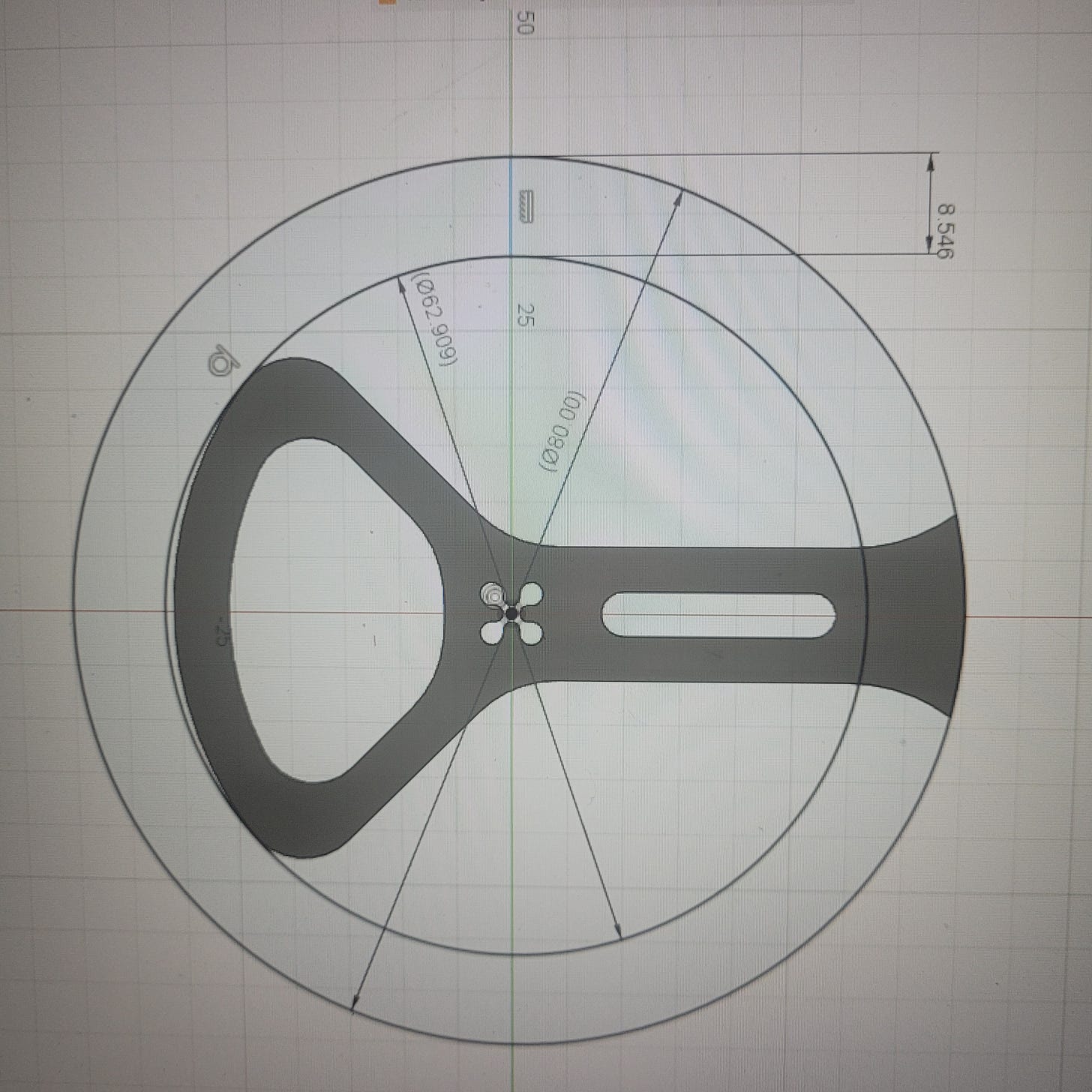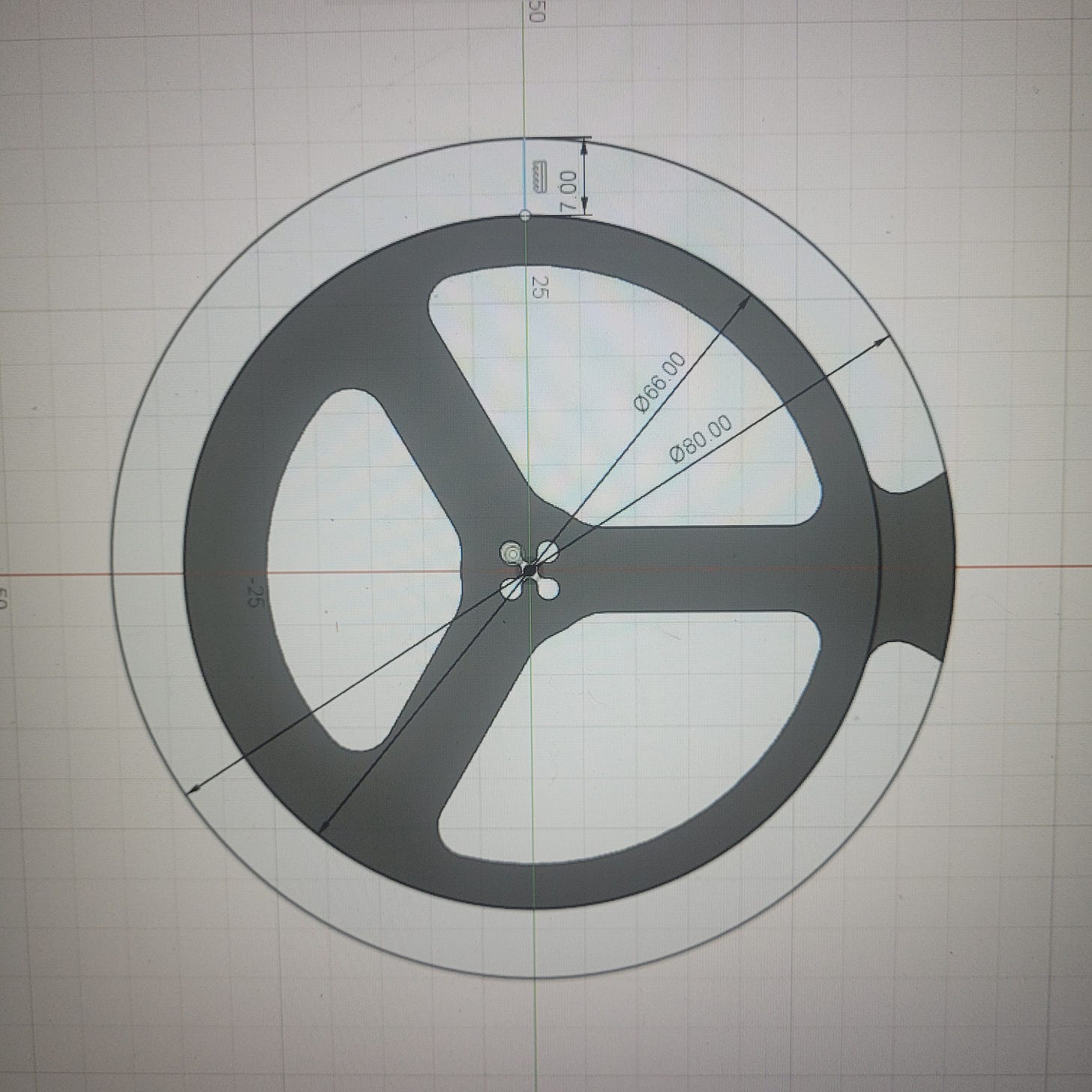Old vs New:
Cad files shown here. As you can see, I kept the same tooth profile. You will note that I used a symmetrical tooth, this is a compromise. a fully asymmetric tooth is technically better, as it reduces the area in which a perpendicularly rotating weapon can strike, increasing your chance on winning weapon on weapon hits. However, my symmetric tooth can be run either way, allowing for a bi-directional weapon, or (most likely) for the weapon to be flipped around when one tooth goes dull, giving you extended weapon life. It also simplifies the balancing process a bit.
You will note a substantial difference in the design of the body of the weapons though. by switching away from the bottle opener shape to the wheel shape, I’m moving a higher percentage of the mass of the weapon further out, increasing Moment of Inertia. This makes the weapon more efficient, i.e. it carries more energy per gram at the same RPM. This is a desirable trait when you are mass limited, and trying to hit as hard as possible. This is also the logic behind the old weapons bottle opener shape, instead of simply giving it a solid counterweight.
The old weapon, at about 13.25 grams, had a MOI of 7560 (g mm^2) or about 570 per gram.
The new Fairy Wheel masses 18.13 grams, but has an MOI of 12889, or about 710 per gram.
That’s almost 25% more efficient. The end result is around 70% more energy carried by the weapon disk at the same RPM, and with the thin spring steel of the wheel vs the thicker titanium of the bar, that energy is applied to a surface area less than half the size. End result? We will see that in the arena, but I hope it will cut into otherwise bouncy TPU better.
But MOI isn’t the only factor to consider when designing a weapon. There is a contrasting factor called bite. This term describes how much engagement your weapon gets, the more engagement, the more effective it is at transferring energy.
The original weapon had an absolute bite of about 8.5mm, that’s measuring from the furthest extent of the counterweight to the radius of the tooth. But the applicable bite is bigger, given that there’s about a third of a revolution between that point and when the weapon engages, making the maximum potential bite over 11mm.
In contrast, the Fairy Wheel has 7mm of absolute bite, and a max potential bite of… 7mm. The outer ring that increases the MOI and energy efficiency also limits the potential bite of the weapon.
This brings us to a third factor. Speed. The higher the RPM of the weapon, the more energy it carries for a given mass, but it also means you get less bite from the weapon. This is the difference between tapping or grinding against the other bot, and landing a solid hit that sends them flying. But you can’t just look at the RPM of the weapon to determine bite, you also need to look at the closing speed between your weapon and it’s target. A faster bot can potentially deliver more bite at a given rpm, or get the same bite at higher rpm.
I use a 2004 brushless motor for my fairyweight, and run a 2s battery. At peak battery voltage of 8.4v, the 1750 kv motor has a theoretical speed of 14700 rpm. There are fancy bite calculators out there, but I break it down to this rule of thumb: A normal speed bot with a single tooth weapon gets the best balance between bite and rpm at around 10k rpm. 2 teeth means half the bite, or half the speed to get the same bite.
Aside: Why would I choose a 1750kv motor when it spins 50% faster than optimum? Because smaller motors tend to spin faster, and 1750kv is the lowest speed option I could find that fit my size and weight limitations. The 1806 brushless is another candidate, but it was just too long to fit my design parameters. (Plus is uses a different screw pattern, hence the slots in the original weapon design.)
In the end, I decided to make my little bot /really fast/ to make it hit harder. Thanks to some high speed n10 motors from www.Turnabot.com, (also the supplier of the Malenki Nano ESC, and the 180mah 2s battery) Lowest Wit can cross a 4 foot arena in under a second.
A final factor in designing a weapon for an insect weight combat robot is: Will it break?
There’s fancy computer simulations that can calculate weak points, but if you don’t have access to those (or know how to use them,) follow this rule when designing your weapon: No hard angles! The only hard angle on your weapon should be the tooth itself. Everything else should make heavy use of fillets, arcs, and curves, ‘cause when you have a hard angle, that’s where you get stress risers. That is where your bot will break. (This applies to inside angles. Outside angles don’t create stress risers the same way, but are a waste of mass.)
Materials choice matters too. Grade 5 titanium is popular for fairyweight bots, it is resilient, light weight, and the small size of the weapons keeps the price from getting too high. AR500 steel is also available in thicknesses down to 1/8”. Rule of thumb, titanium is a little over half the weight of steel, but almost as strong (by weight). The advantage of these materials is availability. www.sendcutsend.com can laser cut a weapon exactly to your specs that you can bolt on and go. But I was looking for something a little more particular.
I wanted to run a hardened steel weapon, but thinner than I could get through the usual sources. So I found a company that would laser cut 1075 spring steel for me in its unhardened condition, and I hardened the steel myself using my knife makers kiln and quenching setup. The use of quench plates after oil allowed me to keep the weapons from warping from the process, and I put a spring temper on em for extra toughness.
All in all, I’ve been impressed by the performance of this new fairy weapon in the test box, and I’m looking forward to getting it into the arena at Maximum Mayhem in Chattanooga in a few weeks.







